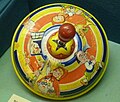History
The collection was originally the work of Patrick Murray (1908–1981), an Edinburgh Councillor and passionate collector of toys and childhood memorabilia. [3] The museum first opened to the public in 1955. In 1957, it moved to its present home on Edinburgh's Royal Mile, in what was formerly the Salvation Army's hall. [4] [5] In 1986, the museum expanded into neighbouring properties to expand the floor and display space. [5]
In 2017, the museum underwent a major refurbishment, including the installation of new display cabinets and lighting for exhibits. The refurbishment also saw the installation of a new digital photo gallery, which offers a look at the changing way children grew up across the 20th century. [5] [1] In 2017, it was estimated that the museum had around 225,000 visitors per year. [5]
Collection
The museum's collection includes around 60,000 objects, from the 18th to the 21st century. [3] [5] Highlights include a teddy bear brought to the UK by a child on the Kindertransport , a dollhouse with working lighting and plumbing systems, a Queen Anne doll from 1740, [2] and a copy of handmade booklet The Life History of a Slum Child by Lileen Hardy . [6] The collection also includes one of the Scottish Government's baby boxes, a maternity package offered to all new parents in Scotland. [7]
The museum has a number of interactive spaces to encourage play amongst younger visitors. [2]
This page is based on this
Wikipedia article Text is available under the
CC BY-SA 4.0 license; additional terms may apply.
Images, videos and audio are available under their respective licenses.








